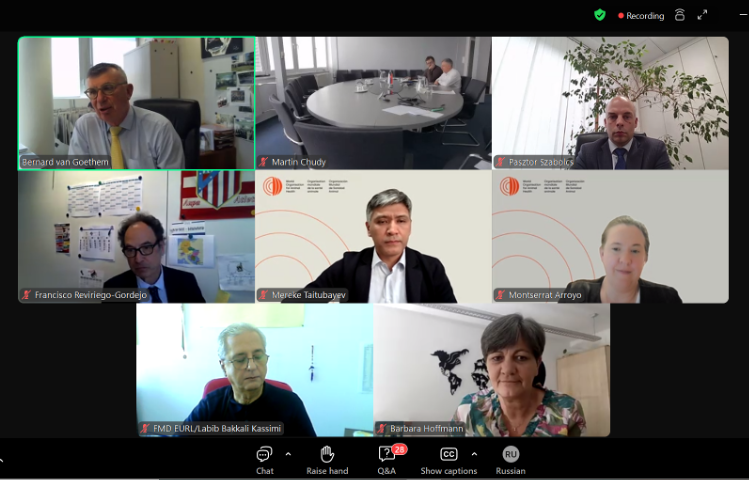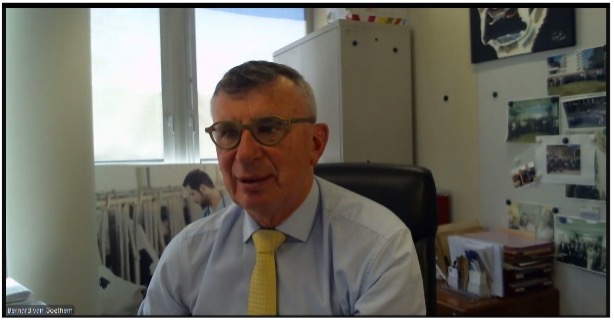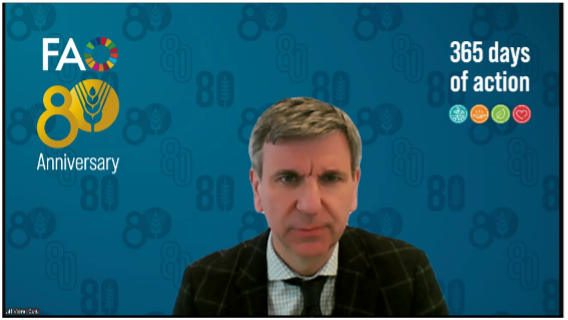In early 2025, the European Union faced the challenge of separate Foot and Mouth Disease (FMD) incursions in Germany in January and in Hungary and Slovakia in March. These events triggered immediate and well-coordinated responses at both national and EU levels, underscoring a commitment to transparency and the strict application of international standards. While Germany successfully contained its single outbreak and regained FMD-free status, Hungary and Slovakia were actively managing a limited number of outbreaks in a specific region.
A global webinar organized by GF-TADs (Global Framework for the Progressive Control of Transboundary Animal Diseases) for Europe on April 7th, 2025, highlighting the commendable transparency exhibited by the EU and the affected Member States in managing the FMD situation.
The President of GF-TADs for Europe, Dr Bernard Van Goethem, FAO Regional Representative for Europe and central Asia Dr Viorel Gutu, WOAH Deputy General Director Dr Montserrat Arroyo and WOAH Subregional Representative Dr Mereke Taitubayev welcomed the participants of the webinar and stressed the importance of joined efforts in controlling animal diseases in the region.
A key takeaway from the webinar was the confirmation that the FMD incursions in Germany and Hungary and Slovakia are epidemiologically distinct and unrelated. The effectiveness of immediately implemented regionalization measures according to EU legislation[1] and the immediate implementation of strict standstills of susceptible animals were strongly emphasized. The critical role of proficient passive surveillance in ensuring very early detection was also recognized.
The possible involvement of human wrongdoing in the initial introduction in both events and human contacts in the subsequent spread of the virus in the event of Hungary and Slovakia is actively under investigation. Weather conditions, particularly wind patterns, were considered an important factor for the spread along the Danube River.
[1] Regulation (EU) 2016/429 and Delegated Regulation (EU) 2020/687
The strong collaborative spirit and effective communication between the affected Member States, the EU Commission and the EURL, as well as with WOAH and FAO were clearly evident. The availability of effective vaccines within the EU and national antigen banks, specifically targeting the identified virus strains, was confirmed. These have been used in Slovakia and Hungary for emergency suppressive vaccination in infected farms awaiting culling operations. Strict restrictions on the movement of live animals and products within and out of the restricted zones were rigorously enforced to prevent further spread of the virus. The safe and responsible handling and disposal of carcasses were treated as a high priority. The EU Veterinary Emergency Team (EUVET) were dispatched immediately on the spot in all 3 countries to provide tailored support on disease control and eradication aspects. Public and media responses to culling activities were closely monitored. Information resources, including official websites and notification systems such as ADIS and WAHIS, were actively utilized to keep all stakeholders well-informed.
Germany reported its FMD outbreak on January 10th, 2025, in a herd of 14 water buffaloes in Brandenburg, near Berlin. Unfortunately, three animals succumbed to the disease. Initial diagnostic ruled out blue tongue disease, confirming the presence of Foot and Mouth Disease virus serotype O. The European Union Reference Laboratory (EURL) further identified the strain as the O/ME-SA/SA-2018 lineage, revealing a 100% genetic match with a sequence reported from Turkey (Igdir/2024).
Upon the suspicion of FMD, Germany immediately implemented standard control measures, establishing a 3 km protection zone and a 10 km surveillance zone. A full stamping-out policy was enacted as systematically required by EU legislation, leading to the culling of the affected water buffalo herd and animals in nearby holdings, including a pig farm and another establishment within a 1 km radius, as well as a contact establishment. Safe disposal of all carcasses was rigorously ensured. A 72-hour standstill for all cloven-hoofed animals was initially imposed in Brandenburg and Berlin, and subsequently extended to manage potential spread.
The Friedrich Loeffler Institute (FLI) swiftly deployed an epidemiological expert team to conduct thorough on-the-spot investigations. This included meticulous tracing of contact establishments, such as routes of practitioners and rendering lorries. Comprehensive sampling and testing were conducted in all establishments within the restriction zones and among identified contacts, with all subsequent results proving negative. Throughout the event, Germany maintained close and regular communication with other federal states and relevant stakeholders, ensuring public awareness through readily available information and press releases. As a precautionary measure in the initial days, Berlin Zoo and Tierpark were temporarily closed. Surveillance efforts were extended to wild cloven-hoofed animals (wild boar and deer) to definitively rule out any spread, with all tests returning negative results.
To ensure the absence of any undetected spread, reiterated checks and samplings were performed based on the distance from the affected holding: three times every seven days within the protection zone and twice every 14 days in the surveillance zone and for contact establishments. Furthermore, fortified passive surveillance in both kept and wild susceptible animals was implemented retroactively from December 1st, 2024, involving the examination of nearly 10,000 samples in the initial weeks, all yielding negative results.
In a strategic move to expedite the regaining of FMD-free status, Germany established an additional containment zone (117 km²) based on a 6 km radius, aligning with World Organisation for Animal Health (WOAH) standards. A comprehensive dossier detailing the epidemiological situation, implemented control measures, and the eradication plan was meticulously prepared through collaboration between Brandenburg and Berlin authorities, the FLI, the EU Commission, and WOAH experts. This dossier was submitted to WOAH on February 16th, 2025, and received approval on March 12th, 2025. Consequently, the rest of Germany was recognized by WOAH as having regained its FMD-free status without resorting to vaccination. The containment zone was based on EU legislation (CID (EU) 2025/323), remained in effect until April 11th, 2025. Establishments within this zone underwent rigorous checks and sampling to confirm the complete absence of the virus. Germany’s application for the acknowledgement of complete freedom from FMD for the entire territory was underway, with anticipation of approval by April 11th, 2025.
Separately, Hungary and Slovakia experienced FMD outbreaks as of March 2025 primarily concentrated close to their respective borders in areas near the Danube River. Importantly, these were identified as distinct epidemiological events involving different virus lineages compared to the German outbreak. The EURL characterized the virus affecting Hungary and Slovakia as the O/ME-SA/PanAsia-2ANT-10 lineage, demonstrating a 100% genetic identity between the strains found in both countries. Phylogenetic analysis revealed the closest genetic links to sequences from Pakistan (2017-18, 99% homology) and Turkey (2024, 98% homology).
Hungary reported its initial suspicion on March 5th, 2025, with laboratory confirmation following the next day. By early April, Hungary had recorded two primary and two secondary outbreaks, all affecting dairy cattle, involving approximately 8,300 animals. Contact holdings, primarily those raising calves for the affected dairy farms, were also impacted. While the initial stamping-out in the first outbreak occurred before vaccine availability, emergency suppressive vaccination was promptly implemented in subsequent outbreaks due to the rapid provision of matching vaccines from Germany. Carcass disposal was carried out through humane killing at the holding using captive bolt, followed by burial at designated sites using secure closed container trucks.
Extensive epidemiological investigations were launched to trace potential sources and transmission routes, including movements of products, animal byproducts, workers, and live animals. Member States that had received live animals from the affected farm in the month preceding the outbreak were immediately notified. While contact tracing outside the initial outbreaks yielded negative results, human factor contact was considered a likely contributor to disease transmission, alongside the potential for windborne spread given the clustered nature of the outbreaks near the Slovakian border. Strict movement restrictions were imposed, including a 72-hour standstill in the western part of Hungary. A nationwide ban on all animal gatherings, including markets, shows, and zoos, was implemented, and the transit of susceptible animals through the further restricted zone was prohibited. Disinfection points were established, and police and military services provided crucial assistance with disease control measures. Intensive sampling efforts involved over 14,000 PCR tests and nearly 45,000 ELISA tests. Public awareness campaigns were actively conducted through various media channels. A dedicated crisis management team and an operative corps, involving multiple national authorities, were established to coordinate the response, with continuous cooperation and information exchange with Slovakian and Austrian competent authorities.
In Slovakia, the first suspicion of FMD arose on March 20th, 2025, with confirmation on March 21st in three holdings in the Dunajská Streda district, near the Hungarian border and the Danube River. By early April, Slovakia had reported six outbreaks, with one occurring in the Malacky district, a development potentially linked to human non-compliance with transmission prevention measures. Upon confirmation, immediate veterinary measures were applied to positive farms and within the designated 3 km protection zone and 10 km surveillance zone, which overlapped the Slovak-Hungarian border. Extraordinary measures were implemented nationwide in Slovakia, including a halt to all movements of susceptible animals within the country (except for direct slaughter), a ban on mass events involving susceptible animals, and restrictions on personnel entry into animal holdings. Enhanced controls on farms and animal transports were enforced, with specific disinfection protocols mandated. While transit through Slovakia was not entirely prohibited, entry for transit was limited to a single border inspection post located outside the restricted zones.
Demonstrating effective international collaboration, Germany provided Slovakia with 10,000 doses of FMD vaccine on March 25th, followed by arrangements for an additional 50,000 doses from the Netherlands. Emergency suppressive vaccination (vaccination to kill) was implemented in the affected holdings. Depopulation in the initial outbreaks was completed by the end of March, with ongoing efforts in the fifth and sixth outbreaks in early April. Clinical signs observed in affected animals were typical of FMD. Strict biosecurity measures, including the thorough disinfection of transport vehicles, were rigorously enforced. Both rendering plants and designated burial sites were utilized for the safe disposal of carcasses. Intensive sampling was conducted, with a significant increase in the number of samples taken daily. Nationwide wildlife monitoring was also intensified, along with enhanced sampling in the further restriction zone. Epidemiological investigations suggested that strong south-southeast winds experienced in March, combined with human factors and potentially the movement of animals between linked farms with insufficient biosecurity, contributed to the initial spread. The outbreak on the sixth farm was strongly suspected to be a result of human error. Export bans from the further restriction zone were strictly enforced, allowing movement of live animals only for immediate slaughter within Slovakia. Active public awareness campaigns and press conferences were conducted to keep the public informed. Contact farms remained closed and under strict sampling protocols, with no suppressive vaccination applied in these holdings.
The European Commission played a vital role in coordinating the response to the FMD outbreaks through its established regulatory instruments and committees. The EU regulatory committee (Standing Committee on Plants, Animals, Food and Feed, SCoPAFF) convened multiple times to discuss and adopt crucial measures related to movement restrictions, the establishment of restricted zones, and the potential application of vaccination strategies. The EU’s regionalisation approach, employing protection zones (3 km), surveillance zones (10 km), and further restricted zones, proved central to containing the disease while ensuring the continuity of safe trade from disease-free areas. The rapid deployment of emergency veterinary experts (EUVET team) to the affected member states provided invaluable, tailored recommendations to address local circumstances. The activation of the EU FMD antigen bank ensured the timely availability of ready-to-use vaccine with well-matched virus strains and a sufficient supply of doses for emergency suppressive vaccination. The EU prioritized transparent communication through information notes, SCoPAFF meetings, dedicated webpages, the ADIS (Animal Disease Information System), and the WAHIS (World Animal Health Information System). Useful links to relevant information were proactively shared with all stakeholders.
As of early April 2025, the FMD outbreak in Germany was considered successfully eradicated, with the country largely having regained its FMD-free status (with the exception of the containment zone). Hungary and Slovakia were actively engaged in combating the disease within the already restricted zones along the Danube River, employing a combination of stamping-out and emergency suppressive vaccination strategies, alongside stringent movement controls and enhanced biosecurity measures. The EU and the affected Member States remain vigilant, continuing thorough epidemiological investigations and maintaining close coordination to prevent any further spread and ultimately achieve complete eradication of the disease from the affected regions. The unwavering commitment to transparency and strict adherence to international standards remains at the core of their collaborative approach.
The webinar was attended by more than 400 participants from 58 countries across all WOAH regions.
Please find below the Agenda, presentations and video recording of the webinar.
Presentations:
Video recording of the webinar:
GF-TADs information webinar on the FMD situation in certain Member States of the European Union


